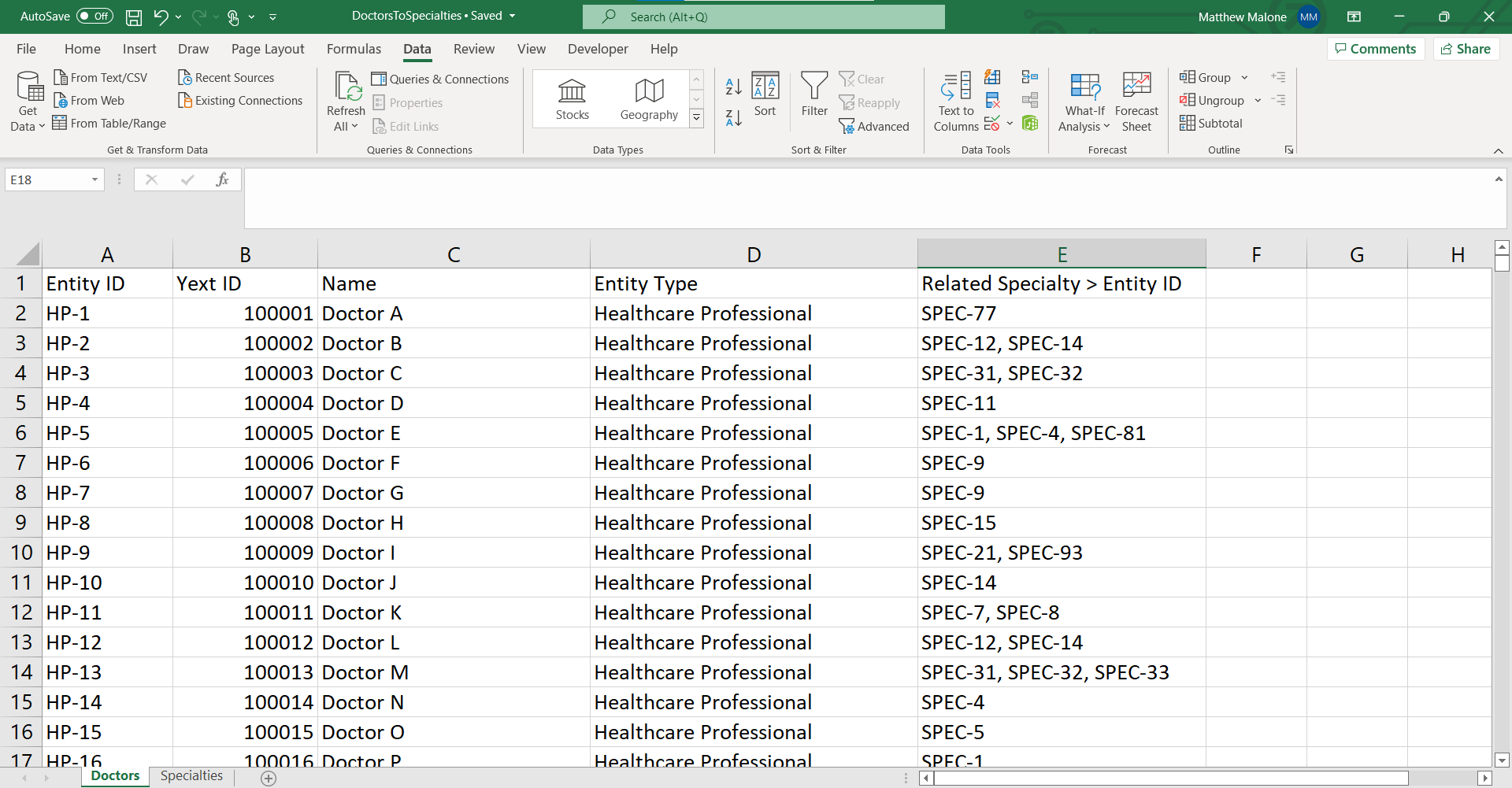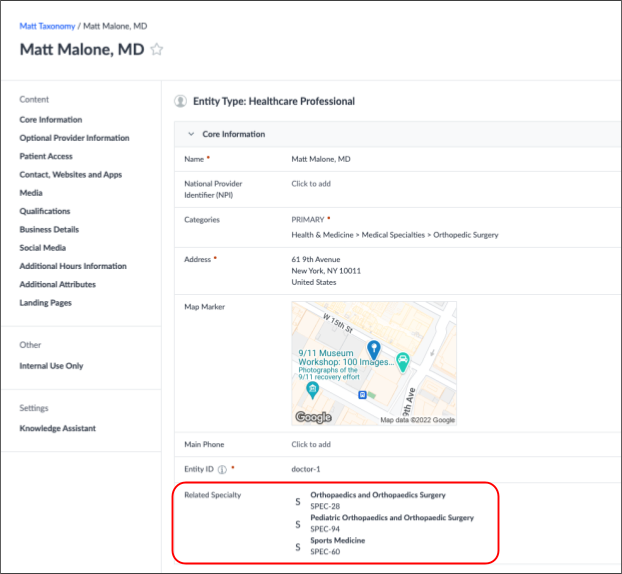Step 2: Integrate the Taxonomy with your Doctors
Now that your account has been populated with the taxonomy, you likely wish to associate your doctors with these entities. If your doctors already have categories assigned, you can use our automated approach, which employs a function connector to assign specialties (and other terms, if you selected the doctors-to-terms data model) based on categories. If your doctors do not have categories assigned, you will have to employ a manual approach to specialty assignments. Both of these approaches are outlined in detail below.
Automated Specialty (and Term) Assignment
If your doctors have categories assigned for Listings or other purposes, we highly recommend taking advantage of our pre-built plugins that will automatically assign a related specialty and/or terms to your doctors. This approach leverages a mapping built by Yext’s healthcare team between these categories and specialties. Note that if a doctor has multiple categories assigned, only the primary category will be used to determine the associated specialty. Follow the steps below to implement this automated solution:
- Navigate to Developer > Developer Console
- In the top right corner, click + Add an App
- Name your app (something like “Taxonomy API Key” is fine). Click Create App.
- Under the API Credentials tab, add an API Permission for the Management API > Entities endpoint. Under Permissions, select Read-Only. Click Save, and then confirm by clicking Change Permissions.
- On the same page, click the eye symbol to view the API Key related to your new app. Copy this API Key down, as you will use it again soon.
- Navigate to one of the following GitHub repositories:
- Visit the Category to Specialty repository ( production / sandbox ) if you wish to auto-populate specialties on your doctor entities.
- Visit the Category to Specialty With Terms repository ( production / sandbox ) if you wish to auto-populate all terms (specialties, subspecialties, procedures, conditions, and reasons for visit) on your doctor entities.
- On whichever repository you selected, click the green <> Code button and then select Download ZIP.
- On your computer, unzip the file and save the folder anywhere on your computer.
- Open up your command line interface (Command Prompt for Windows, Terminal for Mac.)
- If you are using a production account, type in the following command: yext init. If you are using a sandbox account, type in the following command: yext init -u sandbox.
- If you have connected to your taxonomy account before, select Use existing credential and select the account that hosts taxonomy data. Otherwise, select Create new credentials and input the business ID for the account where you downloaded the taxonomy solution.
- Your business ID can be found in the URL of any page in the Yext platform, e.g.
https://www.yext.com/s/[business-id]/homeorhttps://www.yext.com/s/[business-id]/search/overview
- Your business ID can be found in the URL of any page in the Yext platform, e.g.
- You will need to authorize your account if you haven’t used the CLI recently. A browser window will pop up in your browser. Click Authorize in this window.
- Return to the command line interface, and select Yes.
- Type in the following command: yext resources apply /filepath, replacing “filepath” with the file path where you saved your GitHub files on your machine in Step 8. For example, if you downloaded the production repo named categoryToSpecialtyConverter-prod and saved it in your Documents folder, type in yext resources apply /Documents/categoryToSpecialtyConverter-prod-main.
- When asked to confirm whether you’d like to add these resources to your account, select Yes.
- You will then be prompted to input the API Key you generated in Step 5 above. Paste it in the CLI and click return.
- Close the CLI and open your Yext account once again.
- Navigate to Content > Connectors, where you will see a new connector called Category to Specialty Converter or Category to Specialty Converter With Terms.
- Click View on this connector’s row.
- Click Run Connector in the top right corner.
- Wait for the connector to finish running, and all of your doctors’ related taxonomy fields should be populated!
Manual Specialty (and Term) Assignment
You may wish to assign specialties and/or terms manually if you are unable to use the automated approach because your doctors do not use categories. In that case, you can manually integrate the taxonomy with your doctors in the platform or via export and file upload. The former is easier if you manage only a few dozen doctors in Yext, while the latter method is recommended for larger sets of healthcare professionals.
Manual Assignment within the Platform
- Go to your Yext account and confirm that all of your entities have been added to the account by finding “Last Run” dates on each taxonomy connector in Content > Connectors.
- Head to your entities, and filter your content to just Healthcare Professionals.
- Select the first healthcare professional, and scroll down to the taxonomy fields (e.g. Related Specialties, Related Procedures, etc.)
- If you selected the doctors-to-specialties model in the installation flow, your doctors will only have one field: Related Specialties. Populate this field with the doctor’s area of expertise. If you selected the doctors-to-terms model in the installation flow, you should also fill out the fields labeled Related Conditions, Related Procedures, etc.
- Repeat this process for all of your doctors, and you have successfully integrated your doctors with the Healthcare Taxonomy Solution!
Manual Assignment via Data Upload
- Navigate to Content > Entities. Use the toolbar at the top of the page to filter your content by Entity Type.
- If you selected the doctors-to-specialties model during the app installation flow, filter to only Healthcare Professional and Specialty.
- If you selected the doctors-to-terms model during the app installation flow, filter to Healthcare Professional and all other entity types you installed with the connector (e.g. Specialty, Procedure, Condition Treated, etc.)
- Check off all the entities. Make sure they’re all checked off by selecting the dropdown containing a checkbox and clicking Select All in Active Filter.
- Click on the More Actions dropdown and select Export Entities.
- Select Continue.
- On the left hand side, select the fields you’d like to include in the export. The required fields are Entity ID, Entity Type, and Name.
- If you selected the doctors-to-specialties model during the app installation flow, check off Related Specialty > Entity ID as well.
- If you selected the doctors-to-terms model during the app installation flow, check off all of the “related” fields available on the Healthcare Professional entity type, e.g. Related Specialty > Entity ID, Related Procedure > Entity ID, etc.
- When finished, click Continue.
- An export of your doctors and taxonomy specialties/terms will download automatically. Open it in whatever spreadsheet application you prefer.
- One-by-one, add in a comma-separated list of every specialty and/or term associated with each doctor in the relevant column. Remember that these must be listed as the entity’s ID and not its name (e.g. SPEC-82, rather than Pediatric Surgical Oncology).
- To make your life easier, you can cut and paste the specialty and/or term entities you exported into a new Excel tab, and use a VLOOKUP function to cross-reference names and IDs. You only exported the specialty and term entities for reference purposes, and should only be making changes to the Healthcare Professional entities.
- Because this process will likely take a while, make sure to save periodically! You don’t want to lose your progress.
- Once this process is complete, your sheet should look something like the screenshot below. Save the file.

- Go back to the Yext platform and click +Add Data on the Content > Entities page.
- Under Other Options, select Upload File.
- Choose the file you just saved with the doctor entities and go through the upload flow to add related specialties and/or terms to your doctor entities! A final doctor entity should look something like this:


